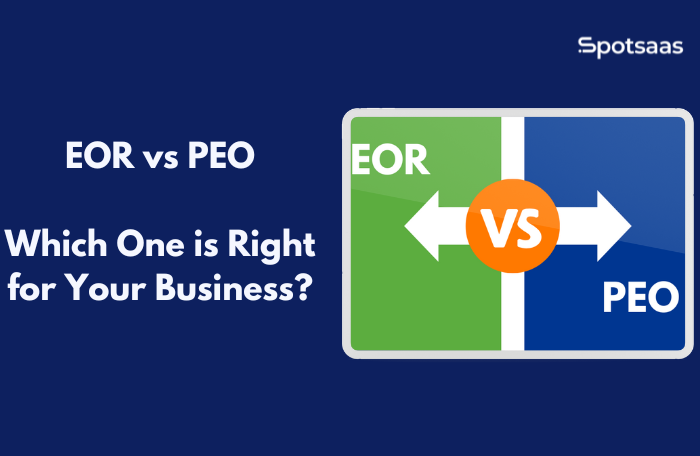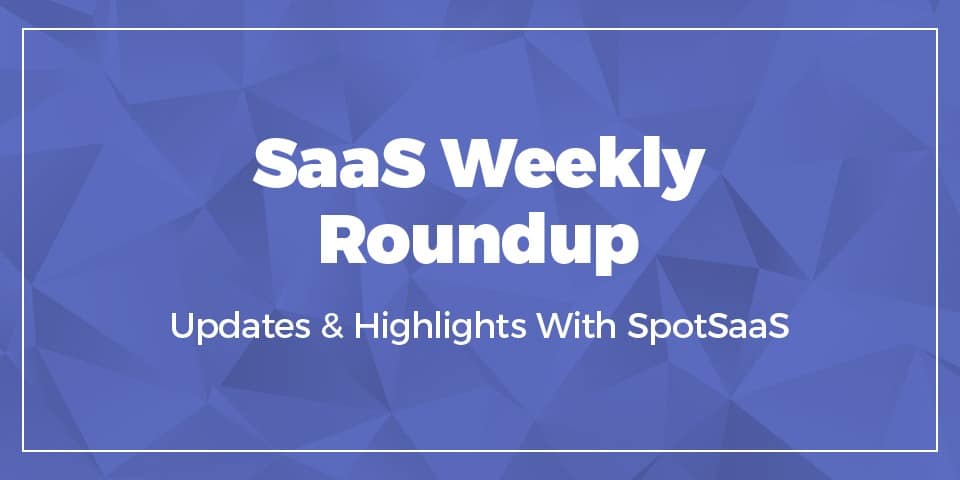EOR vs PEO is a common comparison for growing businesses looking to streamline HR operations or expand into new markets. Both models offer reliable HR support, but they serve very different needs. While an EOR helps businesses hire internationally without setting up legal entities, a PEO is designed to support HR functions within the regions where a company is already established.
An EOR allows companies to hire talent in countries where they don’t have a local entity. It takes on full legal responsibility for employment, covering contracts, taxes, benefits, and compliance. On the other hand, a PEO works on a co-employment model, handling HR tasks like payroll, compliance, and benefits—but only within regions where the business is already legally registered.
For companies weighing these two models, it’s easy to get caught in the confusion. Each serves a different purpose, and the best choice depends on where you’re hiring and how much control you need over the employment process.
What This Guide Covers
For business owners, HR leaders, and operations teams trying to choose between EOR and PEO solutions, this guide offers a clear side-by-side comparison to help you move forward with clarity.
Here’s what you’ll find inside:
- Definitions of both EOR and PEO models and what sets them apart
- Key differences in responsibilities, compliance, and cost
- Who each model is best suited for—based on company size, goals, and geography
- Common scenarios where one option fits better than the other
- How to evaluate the right provider based on your hiring needs
By the end of this guide, you’ll be equipped to make a confident decision on which model aligns with your business goals—whether that means expanding globally or optimizing HR within your home market.
EOR vs PEO
What is an EOR?
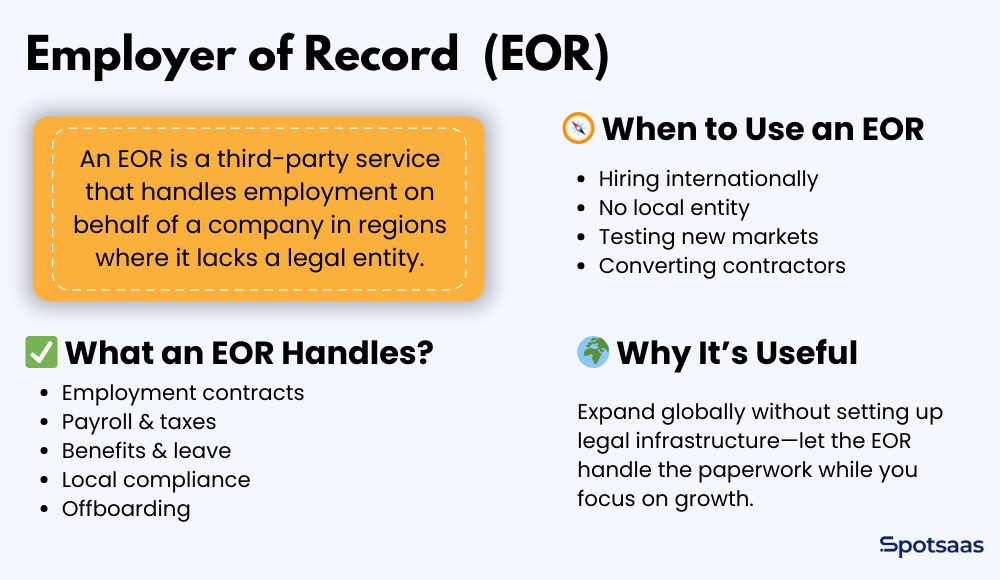
An Employer of Record (EOR) is a third-party service that legally employs workers on behalf of your company, especially in countries where your business doesn’t have a registered entity. While your team manages day-to-day work, the EOR takes care of everything related to employment on paper.
With an EOR, businesses can hire full-time employees in other countries without going through the process of setting up a subsidiary or navigating foreign labor regulations. The EOR becomes the legal employer, managing employment contracts, payroll, tax filings, benefits, and compliance—so your team can focus on operations and growth.
Here’s what an EOR typically handles:
- Drafting and issuing compliant employment contracts
- Running payroll and managing local tax contributions
- Handling statutory benefits and leave policies
- Managing offboarding and employee terminations in line with local labor laws
- Staying updated on regulatory changes to reduce legal risk
When does it make sense to use an EOR?
For businesses looking to enter new international markets quickly, an EOR provides a simple and compliant way to hire without delay. It’s particularly useful for companies that want to test a new region before setting up a legal entity—or build a global team without investing in infrastructure upfront.
Whether you’re hiring one employee or building an entire regional team, EOR services allow you to scale globally with far less friction.
What is a PEO?
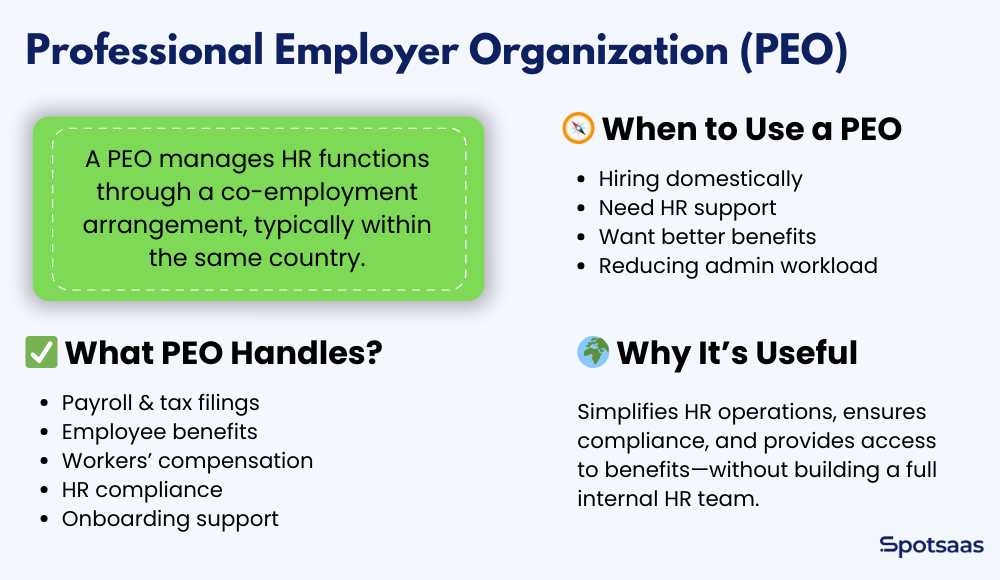
A Professional Employer Organization (PEO) is a service provider that partners with businesses to manage key HR responsibilities through a co-employment model. In this arrangement, the PEO becomes a legal co-employer of your team, sharing certain employer responsibilities while your company maintains control over day-to-day work and decisions.
PEOs are most commonly used by small to mid-sized businesses that want to simplify their HR operations without hiring a large internal team. They support core HR functions—like payroll processing, benefits administration, and labor law compliance—within the country where the business is already registered.
Here’s what a PEO typically handles:
- Payroll and tax filings for domestic employees
- Employee benefits like health insurance and retirement plans
- Workers’ compensation and risk management
- HR compliance and documentation
- Onboarding support and personnel management tools
When is a PEO a good fit?
For businesses based in the U.S., a PEO is especially helpful when managing a growing workforce. It enables access to competitive benefits and ensures compliance with federal and state employment laws—without the cost and complexity of building an internal HR department.
If your company operates domestically and wants to reduce HR overhead while improving employee support, a PEO can be a strong partner.
Key Differences Between EOR and PEO
While both EOR and PEO solutions support businesses with HR and compliance tasks, they operate under distinct models and serve different purposes. An EOR becomes the legal employer on your behalf, while a PEO enters a co-employment relationship—meaning your business remains the official employer.
Understanding how these two models compare is crucial when deciding which one aligns better with your hiring plans and growth strategy. A clear comparison checklist covering ownership, liability, geographic support, and service scope can make the decision process much easier.
 Feature Feature |
 EOR EOR |
 PEO PEO |
|---|---|---|
| Entity Requirement | Not needed | Legal entity required |
| Geography | Global  |
Domestic (usually U.S.)  |
| Employment Model | Full legal employer | Co-employer |
| Compliance | International labor law  |
Local labor law  |
| Best for | Hiring in new countries without an entity  |
Supporting HR for domestic teams  |
Entity Requirement
EOR:
Does not require you to set up a local legal entity. The provider is the official employer in the country where you’re hiring.
PEO:
Requires your business to have a legal entity in place. It operates as a co-employer, not a full legal employer.
Geography
EOR:
Supports hiring across multiple countries, making it ideal for international expansion.
PEO:
Typically supports domestic hiring, most commonly within the United States.
Employment Model
EOR:
Assumes full legal responsibility for your employees, including contracts, tax filings, and compliance.
PEO:
Shares responsibility with your business under a co-employment structure. You retain control over daily operations.
Compliance
EOR:
Manages compliance with international labor laws, adapting to local employment regulations in each country.
PEO:
Handles compliance at the local and federal level within the country of operation, often focusing on state and U.S. labor laws.
Best For
EOR:
Businesses expanding into new countries want to hire employees quickly without setting up legal infrastructure.
PEO:
Businesses operating domestically that want to simplify HR functions and offer competitive benefits without growing their internal HR team.
EOR vs PEO – Who Uses Each Service?
Choosing between EOR and PEO often depends on a business’s location and growth plans. While both offer solid HR support, their ideal users are slightly different.
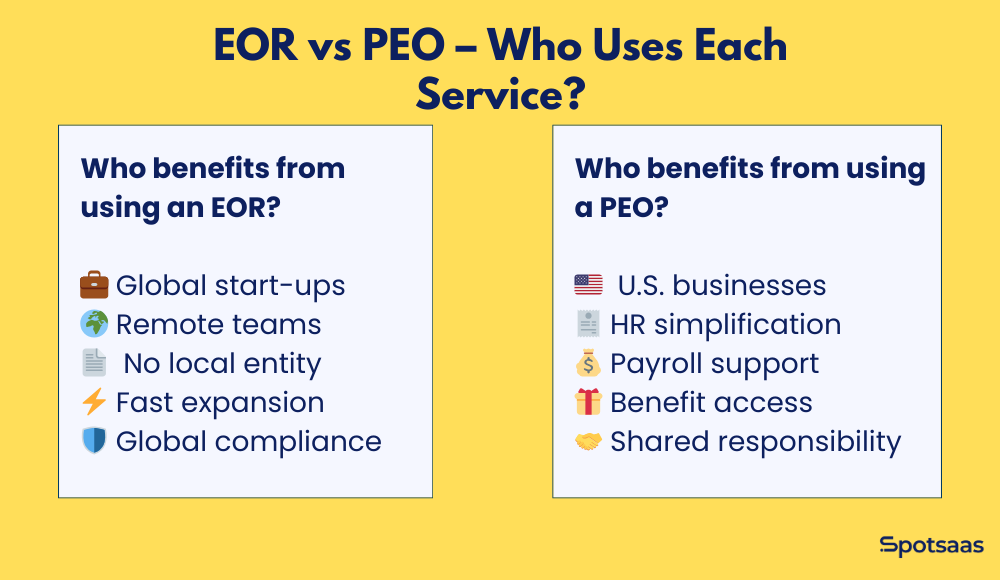
Who benefits from using an EOR?
An Employer of Record is a practical choice for:
- Startups entering new global markets without legal entities
- Remote-first companies hiring international talent across multiple countries
- Scaling teams that need to move quickly and stay compliant without investing in local infrastructure
With an EOR, businesses can onboard international employees in days—not months—and stay focused on operations while the platform handles contracts, tax filings, and compliance.
Who benefits from using a PEO?
A Professional Employer Organization is well suited for:
- U.S. based small and mid-sized businesses that need reliable HR support
- Companies looking to improve benefits offerings and streamline payroll
- Leaders aiming to reduce administrative overhead without building a full in-house HR team
With a PEO, businesses get access to enterprise-level benefits, built-in compliance support, and scalable HR services—all while maintaining control of daily operations.
When Should You Choose EOR vs PEO?
Understanding when to use an EOR versus a PEO often depends on your company’s hiring plans, geographic focus, and internal resources. Here’s a breakdown of common scenarios to help guide the decision.
 Scenario Scenario |
 EOR EOR |
 PEO PEO |
|---|---|---|
| Hiring location |  International International |
 Domestic (typically U.S.) Domestic (typically U.S.) |
| Need for a legal entity |  Not required Not required |
 Required Required |
| Hiring goal |  Test new markets or hire globally Test new markets or hire globally |
 Streamline HR functions locally Streamline HR functions locally |
| Employment structure |  Full legal employer Full legal employer |
 Co-employer Co-employer |
| Benefits offering |  Based on local labor laws Based on local labor laws |
 Access to pooled benefits plans Access to pooled benefits plans |
Choose an EOR if your business needs to:
- Hire employees in countries where you don’t have a legal entity
- Test new markets before fully committing to expansion
- Convert independent contractors to full-time employees in a compliant way
- Build a global team without navigating complex international labor laws
An EOR makes it possible to move quickly across borders while keeping everything aligned with local employment regulations.
Choose a PEO if your business needs to:
- Manage HR, payroll, and benefits within the same country
- Operate with a co-employment structure while maintaining day-to-day control
- Reduces the burden of compliance with local labor laws
- Offer competitive benefits typically available to larger companies—without the associated costs
A PEO is a strong option for companies that want to streamline HR operations while focusing on core business functions.
By aligning your choice with your hiring goals and operational scope, you can build the right foundation for sustainable growth—whether at home or internationally.
EOR vs PEO – How to Choose the Right One
Selecting between an EOR and a PEO starts with understanding how your business operates and where it’s headed. Here are a few key steps to help guide your decision:
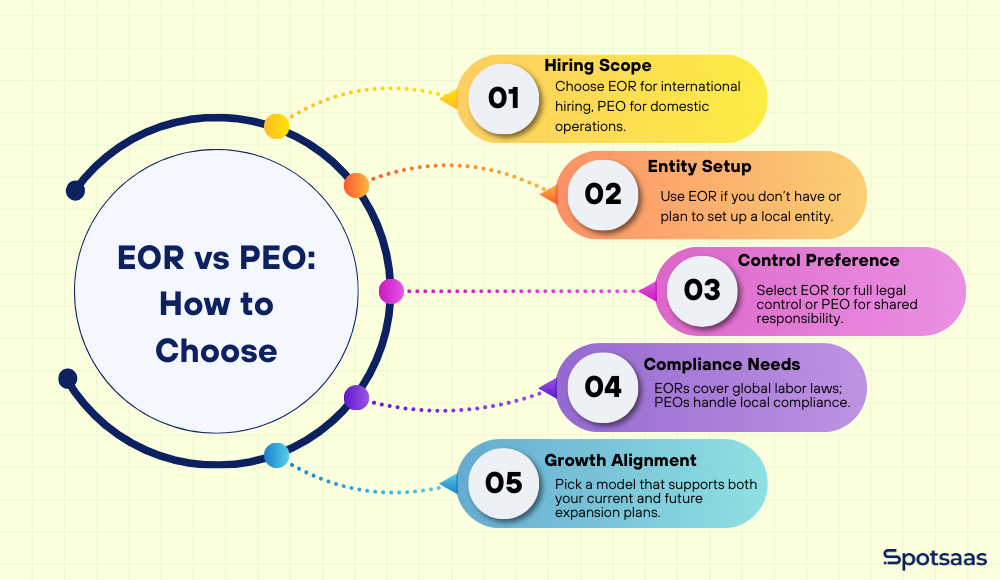
Hiring Scope
Start by identifying whether you’re planning to hire talent internationally or within your existing country of operation. If global hiring is on the horizon, an EOR offers a faster and more compliant path. If your focus is domestic, a PEO may be the more efficient route.
Entity Setup
Take stock of whether you have existing legal entities in the regions where you want to hire. If you don’t—and don’t plan to set them up—an EOR can act as the legal employer on your behalf.
Control Preference
An EOR takes on full legal responsibility, while a PEO shares responsibilities with you under a co-employment model. Consider whether your team prefers full control of HR matters or is comfortable with shared oversight.
Compliance Needs
If local labor laws are unfamiliar or subject to change, having a partner that specializes in compliance is critical. EORs typically offer broader compliance coverage across multiple countries, whereas PEOs focus on domestic regulations.
Growth Alignment
Whether you’re testing new markets or scaling a local team, your hiring model should support that direction. Think beyond the immediate need and choose a structure that allows for flexibility and future expansion.
By following these steps, you can better evaluate which model—EOR or PEO—aligns with your hiring goals and operational strategy.
EOR and PEO Software Providers
Once you’ve identified the right model for your business, the next step is choosing a provider that meets your operational needs and growth goals. Whether you’re exploring EOR platforms or PEO services, today’s software options offer more than just HR management—they’re built to streamline hiring, simplify compliance, and support scalable operations.
| Model | Platform | Overview |
|---|---|---|
| EOR | Deel | Supports onboarding in 150+ countries with fast global payroll |
| EOR | Remote | Focused on compliance, contractor management, and payroll |
| EOR | Oyster | Built for remote teams and global employee experiences |
| PEO | Justworks | User-friendly platform tailored for small teams and startups |
| PEO | TriNet | Industry-specific HR solutions and compliance support |
| PEO | ADP TotalSource | Enterprise-grade payroll and HR services for growing teams |
Leading EOR platforms
If your focus is global hiring, some of the most widely used EOR software include:
- Deel – Offers fast onboarding across 150+ countries
- Remote – Known for strong compliance and payroll automation
- Oyster – Focuses on distributed teams and remote employee support
These platforms handle everything from contract generation to tax compliance, making them ideal for companies hiring internationally without a local entity.
Trusted PEO solutions
For businesses operating domestically, especially in the U.S., top PEO providers include:
- Justworks – Popular among startups for its intuitive interface
- TriNet – Offers industry-specific HR support
- ADP TotalSource – Backed by a strong reputation and deep payroll capabilities
PEOs like these are often used to manage payroll, employee benefits, and HR documentation while helping businesses comply with local labor laws.
| Criteria | Why It Matters |
|---|---|
| Geographic Coverage | Ensure support in countries or regions where you plan to hire |
| Compliance Expertise | Helps reduce legal risk by aligning with local labor laws |
| Software Integrations | Look for compatibility with payroll, HRIS, or accounting tools |
| Pricing Transparency | Understand what’s included and if pricing aligns with your budget |
| Scalability | Choose a provider that can grow with your team and hiring needs |
What to look for in a provider
Regardless of the model you go with, focus on providers that offer the must-have features for global hiring success. Here are a few areas to pay attention to:
- Geographic coverage – Make sure they operate in the regions where you plan to hire
- Compliance expertise – Local legal knowledge matters more than ever
- Software integrations – Seamless connection with your current systems is a big plus
- Cost transparency – Know exactly what you’re paying for and what’s included
- Support and scalability – Pick a platform that can grow with your team
Exploring providers through the lens of these must-have features will help you find a solution that fits your strategy and scales with your needs.
Alternatives to EOR and PEO
While EOR and PEO models cover a wide range of business needs, they’re not the only ways to manage hiring and HR. Depending on your structure, budget, and compliance capabilities, there are other routes worth considering.
Direct hiring through your own legal entity
If your company is already established in a country—or you’re willing to invest in setting up a local entity—direct hiring gives you full control over employment. This approach involves handling everything in-house: payroll, benefits, tax filings, and compliance. It’s often used by larger organizations with local teams or long-term plans in a specific region.
Working with contractors or freelancers
For short-term projects or flexible roles, hiring independent contractors via platforms like Upwork, Fiverr, or Toptal can be cost-effective. You avoid the administrative load of full-time employment, though you must be mindful of classification rules to stay compliant.
Partnering with HR outsourcing firms
Some companies choose to outsource specific HR functions—like payroll, compliance, or benefits administration—without entering a co-employment model. This option works well for businesses that already have entities but want to reduce internal workload and access specialized expertise.
Each of these alternatives has trade-offs. The right choice depends on your hiring goals, how much control you need, and your ability to manage compliance and risk independently.
Conclusion
Choosing between an EOR and a PEO comes down to your hiring strategy, business structure, and operational goals. If you’re expanding into new countries without a local entity, an EOR can simplify global hiring and compliance. For companies focused on domestic growth, a PEO offers valuable HR support through a co-employment model.
Both solutions reduce administrative work and help teams scale more efficiently. By understanding how each model works—and aligning it with your growth plans—you can make a confident, informed decision that supports your team today and creates room for expansion tomorrow.
Frequently Asked Questions
What’s the main difference between an EOR and a PEO?
An EOR becomes the legal employer for global hires, while a PEO shares HR responsibilities within a co-employment model.
Do I need a local entity to use an EOR?
No, an EOR allows you to hire in other countries without setting up a legal entity.
Can a PEO support international hiring?
Most PEOs focus on domestic HR; they usually don’t handle international employment.
Which is faster for global team expansion?
An EOR is typically faster, enabling quick hiring across multiple countries.
Are EOR and PEO services suitable for startups?
Yes—EORs work well for globally distributed teams, and PEOs help streamline local HR for growing companies.


